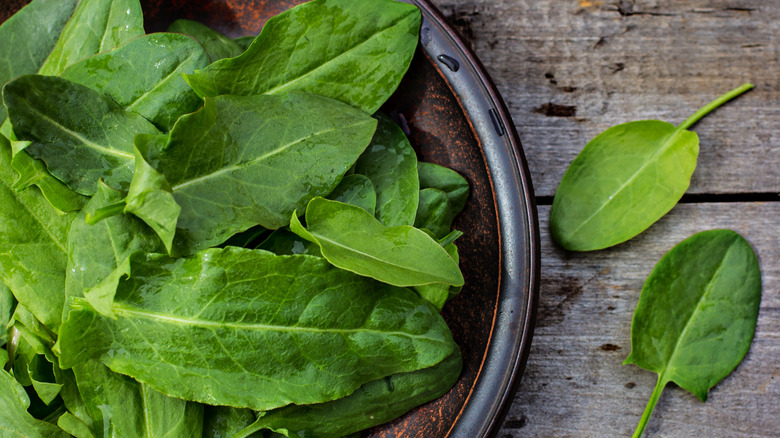A Little Sorrel Goes A Long Way To Balance Heavy Salads
Common contenders for salad bases are romaine lettuce, iceberg, and spring mix, but when it comes to adding other leafy greens to create more flavor, there is a world of possibility. There are endives, chicories, arugula, and even herbs like parsley and cilantro, which can offer a peppery undertone or a refreshing citrus flavor. An even more frequently overlooked leaf is sorrel — one that could be described as an elongated spinach leaf, depending on how young or mature it is.
The name of this sophisticated vegetable means "sour" in French, which aptly describes the flavor profile and aroma of the leaf. In French cuisine, you'll find it used as the main flavor component for cream sauce or as a garnish for a heavy meat dish, but the vegetable also works wonderfully in a fresh plate of salad greens. Described as having a zesty lemon flavor, sorrel can spruce up any bed of otherwise bland leaves.
Use it like an herb to bring more tangy flavor to your salad
These springtime leaves are intensely bitter and get even more so throughout the season. Like other herbs that can be citrusy and sour and pack a punch, sorrel has its own potent flavor that makes using a little of it go a long way. Shorter leaves of sorrel are more suitable for raw consumption, while larger ones should be cooked or, at the very least, blanched. The shorter, younger leaves are tender enough to be worked into a medley of mild lettuces, so bits of sorrel in a mass of neutral lettuce can make your salad eating a more exciting experience.
While numerous recipes use sorrel like an herb — in rich cream sauces or even in sorrel pesto — adding a bit to your heavier salads with cheese or cream-based dressings can balance out the flavors to make them brighter and tangy. Even a hefty salad with potatoes and hard-boiled eggs, like the iconic Niçoise salad, can be elevated with this lemon-flavored green.

